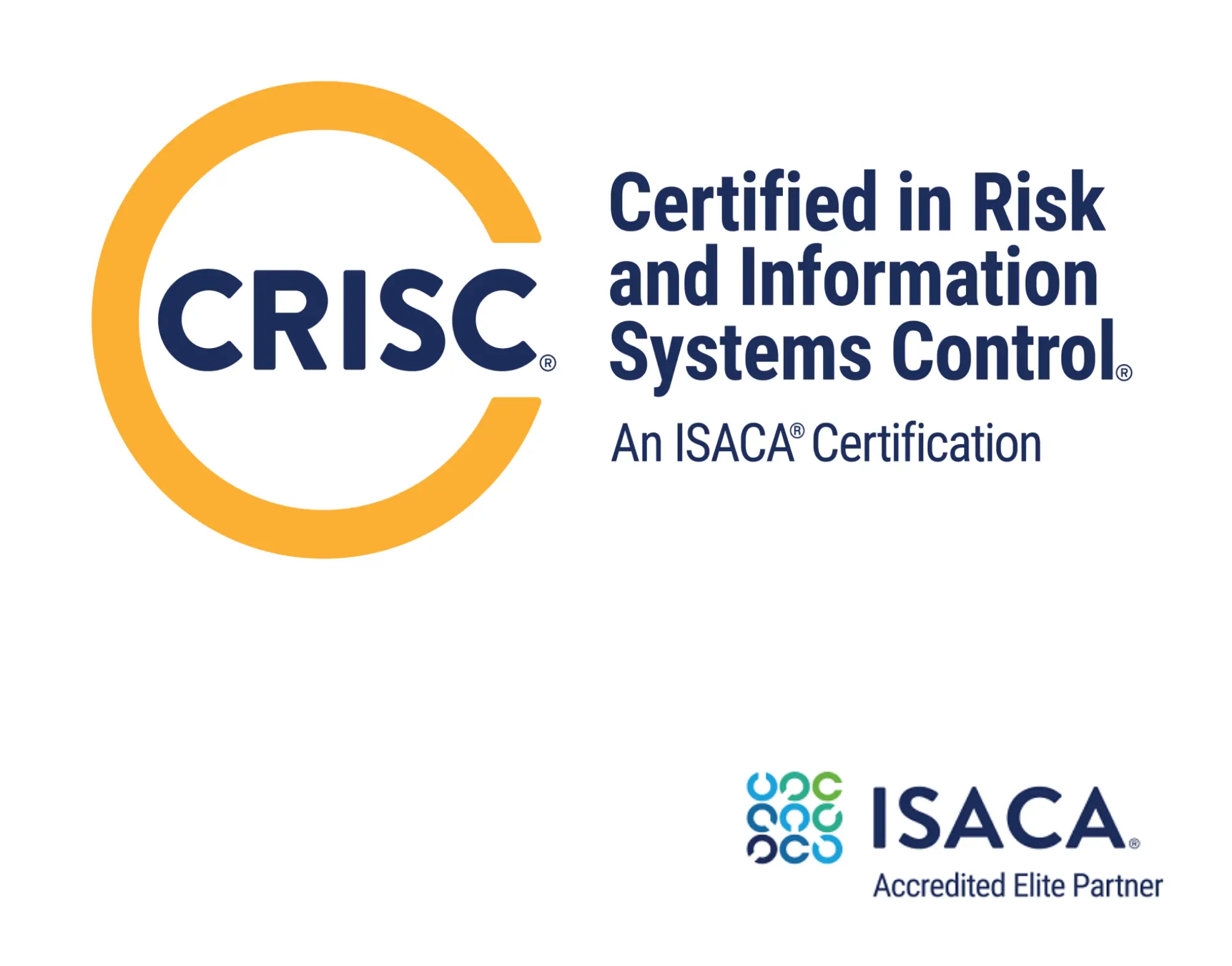Skaffa nya IT-kunskaper, bli certifierad och lyft din IT-karriär till nya höjder utan att spränga banken!
Unlimited Training - IT kurser och certifieringar gjort enkla och otroligt billiga. Få tillgång till 60+ LIVE-kurser för mindre än priset för en kurs.











course: ISACA CRISC Certification (Certified in Risk and Information Systems Control)
Varighet: 3 dagar
Format: Virtual or Classroom


Översikt
Lyft din karriär med ISACA CRISC Certification (Certified in Risk and Information Systems Control) examen. Få specialiserad utbildning för att bemästra risk- och informationssystemkontroll och bli en certifierad expert. Denna certifiering öppnar dörrar till nya karriärhöjder, vilket bekräftar din skicklighet i att hantera och minska risker. Anmäl dig nu för riktad utbildning som säkerställer att du är väl förberedd för att klara CRISC-provet och forma en framgångsrik karriär inom riskhantering.
 instruktörsledd utbildning
instruktörsledd utbildning Practice test
Practice test Självstudiematerial
Självstudiematerial Personlig inlärningsplan
Personlig inlärningsplan Certifieringsgaranti
Certifieringsgaranti E-post, chatt och telefonsupport
E-post, chatt och telefonsupport









Vem riktar sig kursen till?
Certifieringen ISACA CRISC (Certified in Risk and Information Systems Control) är avsedd för dig som arbetar inom området riskhantering och kontroll av informationssystem. Den är utformad för dem som vill validera sina kunskaper och färdigheter i att identifiera, bedöma och minska risker för informationssystem i organisationer. CRISC-certifieringen täcker ett brett spektrum av ämnen relaterade till riskhantering och kontroll av informationssystem, inklusive identifiering och bedömning av risker i informationssystem, utveckling och implementering av riskhanteringsstrategier, övervakning och rapportering av risker i informationssystem och anpassning av riskhantering i informationssystem. med organisatoriska mål och mål.
Kursinnehåll
Förberedelse
På Readynez tillhandahåller vi många resurser och har erfarna experter på området. Det är därför vi också är mycket framgångsrika med många nöjda kunder. Du kan därför tryggt gå din kurs hos oss. För att gå CRISC-kursen krävs dock några förkunskaper.
Du har den perfekta utgångspunkten för att ta den här kursen med dessa förkunskaper:
Möt några av de instruktörer du möter på din kurs. De är experter, passionerade inom sina områden och dedikerade till att hjälpa de som vill lära sig, utforska och bli framgångsrika i sina karriärer.

Kevin Henry är en globalt erkänd expert som i över 20 år har bidragit till att utbilda och certifiera människor inom IT-säkerhet, inklusive CISSP, CISM, CISA och andra.
Kevin Henry is a well-known and highly respected expert instructor with Readynez.
Kevin has served for many years as an authorised instructor for (ISC)2 and he is renowned for his 20-year contribution to learners training for IT security skills- and certifications such as the CISSP, CSSLP, CISM, CISA and CCSP everywhere in the world.
Kevin is a force to be reckoned with, being an authorised instructor and training no less than 9.000 online learners monthly in the fields of information security and audit, in addition to the many students that attend his instructor-led courses with Readynez
He is also one of the most highly-rated instructors and most often he is given scores of 10/10 by his students with comments like these:
“Fantastic teaching and coaching”
Fredrik Palmquist Orange
“Most Excellent educator”
Jens Johanson Trafikverket

James Rowney är en välkänd expert med över 20 års bidrag till utbildning av IT-säkerhetsfärdigheter.
James has worked on many large mission critical environments in some of the largest companies in their industries.
Understanding business requirements and drivers are essential to any strategy and design. Understanding environments are key to any application or infrastructure changes, both the immediate services they interface with and those beyond. A failure to satisfy Non Functional Requirements can not be fixed by a process.
Specialties: CISSP, CCSP, AWS Solution Architect Associate, TOGAF 9 certified 86080 member of The Association of Enterprise Architects (AEA) - 27519830. BCS Solution & Enterprise Architect Certified - AMBCS - 990529878, Linux RHCE V5 expired, RHCVA Unix, Storage, SAN, Netbackup, Clusters, Design and Delivery of Infrastructure.

Friedhelm har mer än 30 års erfarenhet inom IT, säkerhet och datasekretess som senior informationssäkerhetskonsult.
Friedhelm Düsterhöft is a Senior Information Security Consultant, Auditor, Trainer and Managing Director, and has 30+ years of work experience in IT, Information Security and Data Privacy.
He has contributed to various PECB whitepapers and articles, such as ’Information Security in Banks and Financial Institutions’, ‘What Does SIEM Stand For?’, ‘Why Organizations Fail to Pass an Audit’ and “How to Integrate ISO/IEC 27032 Cybersecurity with ISMS?’.
FAQ
ISACA CRISC-certifieringen (Certified in Risk and Information Systems Control) är en globalt erkänd legitimation utformad för yrkesverksamma som hanterar och övervakar företagsriskhantering och kontroll av informationssystem. Den validerar expertis i att identifiera och hantera IT-relaterade risker, implementera informationssystemkontroll och säkerställa anpassning mellan affärsmål och riskhanteringsstrategier. CRISC-certifiering förbättrar karriärmöjligheterna för individer som är involverade i riskhantering, IT-kontroll och styrning.
Styr din karriär med Readynez specialiserade kurs för ISACA CRISC (Certified in Risk and Information Systems Control) examen. Få de färdigheter som behövs för att navigera i det komplexa landskapet av riskhantering och kontroll av informationssystem. Vår expertledda utbildning säkerställer att du är väl förberedd för att klara CRISC-provet och bli en certifierad professionell. Gå med i Readynez och lås upp möjligheter att utmärka sig inom riskhantering.
För att kvalificera dig för CRISC måste du ha 3 års erfarenhet av riskhantering och kontroll av informationssystem under de senaste 10 åren från ansökningsdatumet.
Kostnaderna för att erhålla ISACA CRISC-certifiering inkluderar examensavgifter (som sträcker sig från $575 till $760 för ISACA-medlemmar och $760 till $965 för icke-medlemmar), studiematerial (som officiella CRISC-granskningsmanualer och övningsfrågor online) och möjliga utbildningskurser eller workshops för förberedelser.
ISACA CRISC-examensplanen utforskar fyra viktiga domäner inom riskhantering och kontroll av informationssystem. Kandidater fördjupar sig i riskidentifiering, bedömning av sannolikhet och påverkan, utvecklar effektiva svar och begränsningsstrategier och övervakning/rapportering om risk- och kontrolleffektivitet. Denna omfattande examen säkerställer skicklighet i att navigera i det komplexa risklandskapet, förbereda individer att utmärka sig i roller som involverar riskhantering och kontroll av informationssystem.
Ja, ISACA CRISC-certifieringen (Certified in Risk and Information Systems Control) ökar din karriär avsevärt. Globalt erkänd, validerar den din expertis i att hantera IT-relaterade risker och implementera robust informationssystemkontroll. CRISC förbättrar professionell trovärdighet och frigör olika karriärmöjligheter inom riskhantering, IT-styrning och kontroll av informationssystem.
Tiden det tar att bli certifierad ISACA CRISC (Certified in Risk and Information Systems Control) kan variera beroende på faktorer som din befintliga kunskap, erfarenhet och den tid du kan ägna åt förberedelser. I allmänhet kan kandidater tillbringa flera veckor till några månader för att förbereda sig för provet genom självstudier, utbildningar och praktisk erfarenhet.
ISACAs CRISC-certifieringsprov är datorbaserade och administreras på auktoriserade PSI-testcenter globalt eller som fjärrkontrollerade prov. CRISC-examensregistreringen är kontinuerlig, vilket innebär att kandidater kan registrera sig när som helst, utan begränsningar.
Svårighetsgraden för ISACA CRISC (Certified in Risk and Information Systems Control) examen kan variera beroende på din nivå av erfarenhet, kunskap och förberedelser. CRISC-provet är utformat för att bedöma färdigheter i riskhantering och kontroll av informationssystem, och det täcker omfattande domäner. För personer med en stark bakgrund inom riskhantering och kontroll av informationssystem kan grundliga förberedelser och praktisk erfarenhet göra provet mer hanterbart.
Kandidater måste uppnå minst 450 för att klara provet. ISACAs CRISC-certifieringskommitté har definierat ett minimalt kunskapskriterium på 450 poäng.
ISACA kräver att certifierade individer, inklusive de med certifieringen Certified in Risk and Information Systems Control (CRISC), engagerar sig i fortbildningsaktiviteter (CPE) för att behålla sin certifiering. CPE-aktiviteter hjälper till att säkerställa att certifierade yrkesverksamma håller sig uppdaterade med utvecklande branschpraxis.
Recensioner

Readynez är den bästa utbildningsleverantören jag har använt på många år. Deras kundservice är förstklassig, priserna är mycket konkurrenskraftiga och instruktörerna är excellent.

Lätt att delta över Teams och en utmärkt instruktör gav mig stort värde för den tid jag investerade.
Varför betala mer?
Varför nöja sig med bara en certifieringskurs när du kan delta på ALLA certifieringskurser till ett pris som är lägre än priset för en kurs?

Ett perfekt sätt för oss att utveckla de kompetenser vi behöver för att bli framgångsrika
![]() Kasper Meyer Christensen
Kasper Meyer Christensen
Verksamheter som använder Unlimited Training sparar minst 50% på sin utbildning och certifiering - och många upp till 80%
Deltagare med Unlimited Training licens genomför i genomsnitt 2,4 kurser per år

För ett pris som är lägre än priset för en kurs

Bara billigare och mer flexibelt

Det enklaste, billigaste och mest flexibla sättet att bli certifierad på

Deltag på så många kurser du vill - inga begränsningar!

Vi betalar tillbaka om kostnaden för licensen överstiger värdet på din utbildning

Interagera 1-till-1 med 50+ erfarna instruktörer

